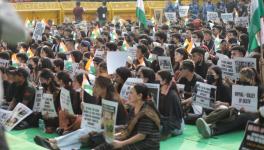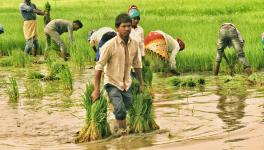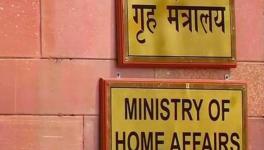Manipur's Leaky Implementation of the National Rural Drinking Water Programme
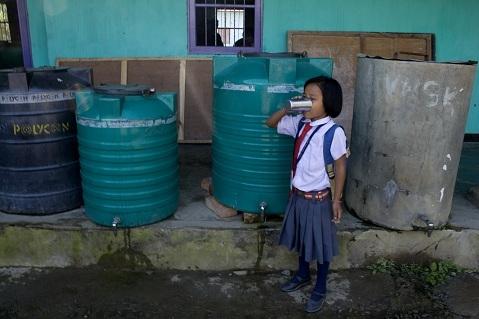
A report from the Comptroller and Auditor General of India (CAG) has revealed irregularities in the implementation of the National Rural Drinking Water Programme (NRDWP) in Manipur. Discrepancies of almost Rs. 3 crore in implementing the NRDWP over a period spanning 2012 to 2017 were reported by the CAG. The report was tabled on July 23.
Read Also: Loktak Lake Scam: Much More than Just Unaccounted Transfers
According to the report Public Health Engineering Department (PHED) is the primary executing agency for drinking water schemes. The State Water and Sanitation Mission (SWSM) operates under the Chief and Additional Chief Secretary of the PHED. According to the Rules framed, the Apex Committee of the SWSM is expected to meet at least twice a year, however, in the case of Manipur, the Committee met only once a year with no meetings in the financial year 2013-2014. The report noted the same situation in the other implementing mechanisms. If meetings are not conducted regularly, how will anybody know if the scheme is successful?
The agency tasked with troubleshooting gaps in the PHED's plan – the State Technical Agency (STA) – has never been constituted. Though the PHED stated that they never formed the STA due to a large number of qualified people existing within the department, the CAG did not accept their reasoning. The PHED had not formulated a plan for implementing the scheme either.
As far as the financial irregularities are concerned, the CAG was suspicious of an expenditure of Rs 2.97 crore. Pipes, for which payments of Rs. 41.61 lakh had been made, were found undelivered in Senapati and Churachandpur districts in the state. Payments worth Rs. 42.68 lakh had already been made for incomplete work. Thus, the residents of Toupokpi and Nongmaikhong villages were deprived of drinking water. The PHE, Thoubal division, had awarded a tender for providing water to Langmeidong in 2010. The tender was valued at Rs. 48.89 lakh, and the work was recorded as ‘completed’ in 2013. The contractor was paid Rs. 47.68 lakh for the work in 2016. However, the CAG noticed that an additional expenditure of Rs. 18.44 lakh was paid to another contractor between 2012 and 2015 for laying pipelines, etc. The spot verification found that the work had, in fact, not been completed, and the CAG found no evidence of pipes being laid.
Between 2013 and 2015, the department attempted to revive a tank in Kekmayai which was abandoned. The department spent Rs. 5.17 lakh on laying pipes as well as a chowkidarquarter. The CAG's spot verification found the place still abandoned and that there was no evidence that the work had even been attempted.
The report also highlighted a curious case wherein a contractor incurred a cost higher than the estimated cost of the work and was paid less than the value of the work done. In 2010, the PHE of Thoubal division had started a drinking water scheme for Bitra. The estimated cost was Rs. 12.88 lakh. The contractor was paid Rs. 13.23 lakh for the work costing Rs. 13.92 lakh. However, the work had, in fact, not been completed.
The PHE of Kangpokpi Division in Senapati district had incurred an expenditure of Rs. 43.02 lakh towards purchasing construction materials and laying pipes. The scheme was meant to provide drinking water to 227 government schools and 108 anganwadi centres. The work was executed through two non-government organisations and four contractors without ever inviting tenders. The CAG found that apart from this irregularity, there were no documents to show that the scheme had been executed or the payments were made.
A similar sequence of events took place in Thoubal. The PHE had commissioned work for providing drinking water to 100 anganwadi centres for Rs. 19.69 lakh in 2013. The work was recorded as having been completed the same year. However, the database provided to the CAG showed that there were only 72 anganwadi centres in Thoubal.
The CAG also noted that expenditure not covered under the programme had been charged to it. An expenditure towards developing office infrastructure worth Rs. 16.38 lakh had been incurred by the Churachandpur PHE. The programme does not allow expenditure towards constructing laboratories either. However, Rs. 10 lakh had been diverted for constructing divisional laboratories in Lamphelpat. The Bishnupur PHE division had diverted Rs. 12.34 lakh for constructing a conference hall. The expenditure included buying a conference microphone, LED TV, mobile phones, an almirah and a table. The Thoubal PHE division diverted Rs. 27.15 lakh for two vehicles. One vehicle was issued to the Minister of PHED and the other was issued to the Chief Engineer of the PHED.
Also Read: How the Mapithel Dam in Manipur is Affecting its Natives
The report noted that the PHED had undertaken installing rainwater harvesting systems for schools and anganwadis under the head of sustainability. The storage tanks provided were of 300, 500, and 1000 litres. The CAG found this to be 'unsustainable'.
What was also worrying was that in terms of support activities, the programme was in a disarray. The water quality and surveillance aspect of the programme was severely understaffed and without infrastructure. The state laboratory was operating at half its strength – seven posts filled against a sanctioned strength of 14. Further, out of 78 parameters to be monitored, the lab could only monitor 14 of them.
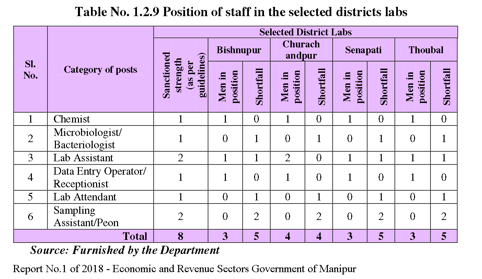
The table above portrays the state of affairs in the district laboratories. None of the district laboratories are operating at the sanctioned strength. More than half the laboratories are operation at half the strength or less. It would be difficult to imagine these laboratories being able to successfully detect pathogens and other contaminants to pre-empt a crisis.
The state of the NRDWP's implementation could be a result of funds making their way to the undeserving pockets. It could also be a natural outcome of the lack of planning. What is evident is that the beneficiaries of all these grand schemes have little access to drinking water. However, those who do have access are walking a tight rope, as the testing laboratories are understaffed and ill-equipped. Whether the state government will take any action or at least take note of the report is yet to be seen.
Get the latest reports & analysis with people's perspective on Protests, movements & deep analytical videos, discussions of the current affairs in your Telegram app. Subscribe to NewsClick's Telegram channel & get Real-Time updates on stories, as they get published on our website.











